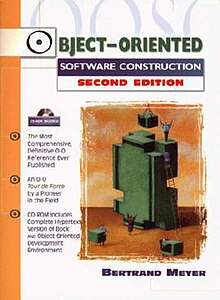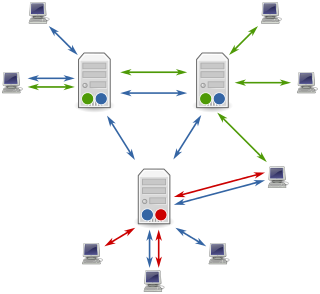
Kent Beck is an American software engineer and the creator of extreme programming, a software development methodology that eschews rigid formal specification for a collaborative and iterative design process. Beck was one of the 17 original signatories of the Agile Manifesto, the founding document for agile software development. Extreme and Agile methods are closely associated with Test-Driven Development (TDD), of which Beck is perhaps the leading proponent.

The Z notation is a formal specification language used for describing and modelling computing systems. It is targeted at the clear specification of computer programs and computer-based systems in general.

Design by contract (DbC), also known as contract programming, programming by contract and design-by-contract programming, is an approach for designing software.
In computer programming, a precondition is a condition or predicate that must always be true just prior to the execution of some section of code or before an operation in a formal specification.
In computer programming, a postcondition is a condition or predicate that must always be true just after the execution of some section of code or after an operation in a formal specification. Postconditions are sometimes tested using assertions within the code itself. Often, postconditions are simply included in the documentation of the affected section of code.
In software engineering, a software design pattern is a general, reusable solution to a commonly occurring problem within a given context in software design. It is not a finished design that can be transformed directly into source or machine code. It is a description or template for how to solve a problem that can be used in many different situations. Design patterns are formalized best practices that the programmer can use to solve common problems when designing an application or system.
Command–query separation (CQS) is a principle of imperative computer programming. It was devised by Bertrand Meyer as part of his pioneering work on the Eiffel programming language.

Grady Booch is an American software engineer, best known for developing the Unified Modeling Language (UML) with Ivar Jacobson and James Rumbaugh. He is recognized internationally for his innovative work in software architecture, software engineering, and collaborative development environments.
In computer programming, specifically object-oriented programming, a class invariant is an invariant used to constrain objects of a class. Methods of the class should preserve the invariant. The class invariant constrains the state stored in the object.
Object-oriented analysis and design (OOAD) is a popular technical approach for analyzing and designing an application, system, or business by applying object-oriented programming, as well as using visual modeling throughout the development life cycles to foster better stakeholder communication and product quality.
In object-oriented programming, inheritance is the mechanism of basing an object or class upon another object or class, retaining similar implementation. Also defined as deriving new classes from existing ones and forming them into a hierarchy of classes. In most class-based object-oriented languages, an object created through inheritance acquires all the properties and behaviors of the parent object. Inheritance allows programmers to create classes that are built upon existing classes, to specify a new implementation while maintaining the same behaviors, to reuse code and to independently extend original software via public classes and interfaces. The relationships of objects or classes through inheritance give rise to a directed graph. Inheritance was invented in 1969 for Simula.
Peter Coad is a software entrepreneur and author of books on programming. He is notable for his role in defining what have come to be known as the UML colors, a color-coded notation chiefly useful for simplifying one's understanding of a design or model.
In object-oriented programming, the open/closed principle states "software entities should be open for extension, but closed for modification"; that is, such an entity can allow its behaviour to be extended without modifying its source code.

EiffelStudio is a development environment for the Eiffel programming language developed and distributed by Eiffel Software.
SCOOP is a concurrency model designed for the Eiffel programming language, conceived by Eiffel's creator and designer, Bertrand Meyer.
Prentice Hall International Series in Computer Science is a series of books on computer science published by Prentice Hall. The series' founding editor was Tony Hoare. Richard Bird subsequently took over editing the series. Many of the books in the series have been in the area of formal methods in particular.
The TOOLS conference series is a long-running conferences on object technology, component-based development, model-based development and other advanced software technologies. The name originally stood for "Technology of Object-Oriented Languages and Systems" although later it was usually no longer expanded, the conference being known simply as "the TOOLS conference". The conferences ran from 1988 to 2012, with a hiatus in 2003-2007, and was revived in 2019.








